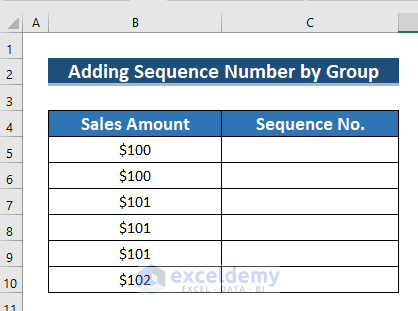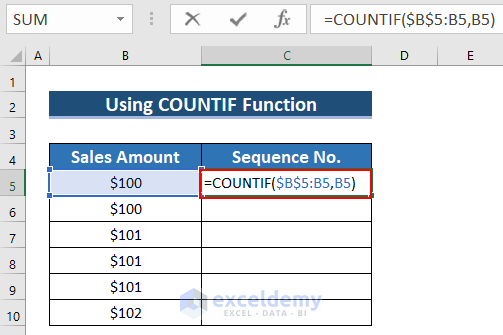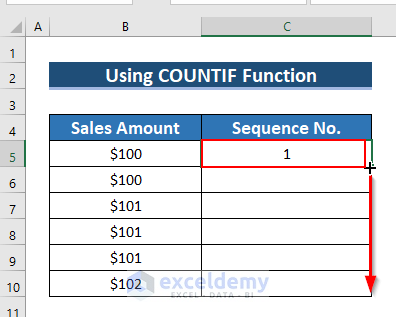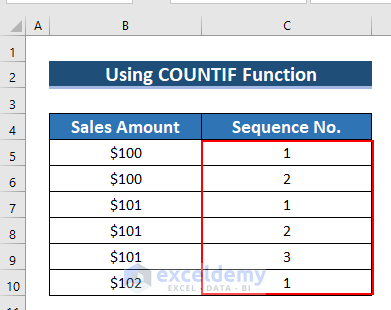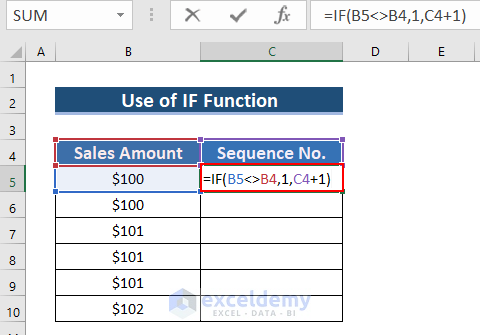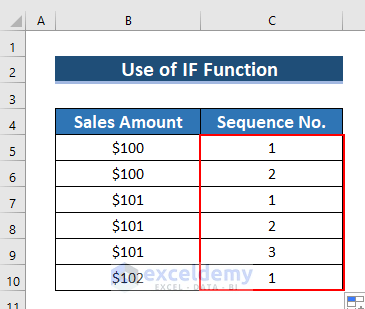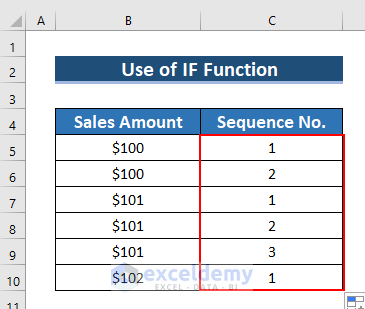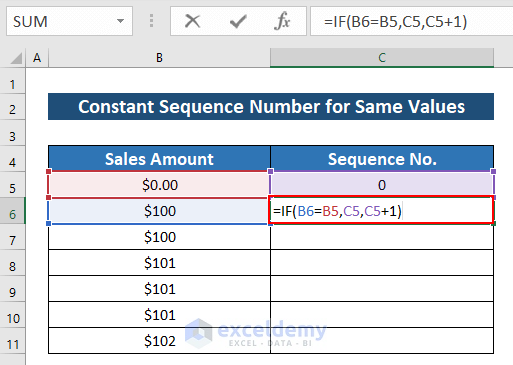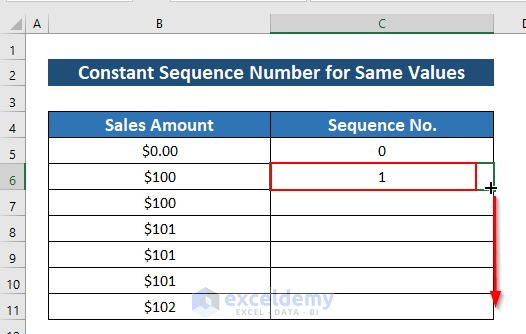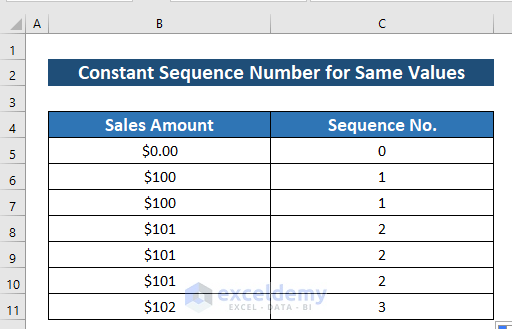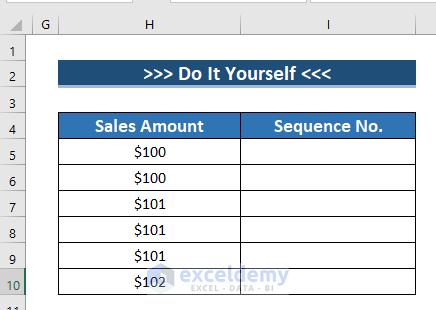We work in Excel mostly for official and business purposes. Sometimes we need to give sequence numbers by Group. In this article, we are going to discuss how to add sequence number by group in Excel. Sequence number by group means to give sequence number to all members in a certain group.
How to Add Sequence Number by Group in Excel: 2 Ways
In the following dataset, you can see the Sales Amount and Sequence No. columns. Next using the COUNTIF and IF functions we will add sequence number by group in Excel. For smooth data presentation, first, sort the data in any order like ascending or descending order. Here, we used Excel 365. You can use any available Excel version.
1. Using COUNTIF Function to Insert Sequence Number by Group
In this method, we will use the COUNTIF function to add sequence numbers by a group in Excel.
Here we will use the COUNTIF function to count and autofill sequence numbers of every cell in a group of our data range.
Steps:
- In the beginning, go to Cell C5.
- Then, Write the COUNTIF function.
- After that, select the range for the 1st argument. Here, we will use the absolute reference value for the starting value of the range. And end value will be for which cell we want the sequence number.
- Moreover, in the 2nd argument, we will select the criteria. Here criteria will be the cell for which we want the sequence number.
- After putting all the values our formula will be:
Formula Breakdown
- COUNTIF($B$5:B5, B5) → The COUNTIF function counts an array of cells that meets certain criteria.
- $B$5:B5 → is the array.
- B5 → is the criteria.
- Output: 1
- At this moment, press ENTER.
- Therefore, we will get the sequence number for Cell B5.
- Moreover, we will pull down the Fill Handle icon from Cell C5 to C10.
Therefore, you can see the complete Sequence No. column. Here we get sequence numbers for every group. We will have a clear view from this image that which group has how many members.
Read More: How to Enter Sequential Dates Across Multiple Sheets in Excel
2. Use of IF Function to Add Sequence Number by Group
Here, we will compare our cell values with a condition. After that, we will find out sequence numbers based on the comparing values.
2.1. Using IF Function When Sequence Number Is Not Constant
Here, we will add a sequence number using the IF Function when the sequence number is not constant for the same value.
Steps:
- In the beginning, go to Cell C5.
- Then, write the IF function.
- Now, define the condition in the 1st argument. Set a condition that Cell B5 and B4 are not equal in this cell. If the condition is TRUE, then the return value will be Otherwise, the argument will add 1 with Cell C4. Here C4 is 0, as our cells start from So, the formula becomes:
=IF(B5<>B4,1,C4+1)- Now, press ENTER, and we will get the sequence number for Cell B5.
- Furthermore, we will pull down the Fill Handle icon from Cell C5 to C10.
As a result, you can see the complete Sequence No. column.
Now, get the sequence number for all the cells by the group. If our data set values are irregular, then first we need to sort the values by ascending or descending order. And thus we can autofill data in ascending or descending order.
2.2. Applying IF Function for Constant Sequence Number
We can also use the IF function to present data in another way. We can give fixed sequence numbers to every group, not to the members of the group.
For this, we insert a row between the heading and data, and the process is given below.
Steps:
- In the beginning, we put 0 in cells B5 and C5.
- After that, go to cell C6.
- Then, write the IF function.
- Afterward, define the condition in the 1st argument. Set a condition that Cell B6 and B5 are equal in this cell. If true, then the return will be Otherwise, add 1 with Cell C5. So, the formula becomes:
=IF(B6=B5,C5,C5+1)
- Moreover, press ENTER, and we will get the sequence number for cell B6.
- After that, pull down the Fill Handle icon from cell C6 to C11.
Hence, you can see the complete Sequence No. column.
Here, we will get the sequence number for every group. By the sequence number, we can identify the groups easily.
Read More: How to Repeat Formula Pattern in Excel
Practice Section
You can download the above Excel file and practice the explained methods.
Download Practice Workbook
Download this practice workbook to exercise while you are reading this article.
Conclusion
In this article, we explained how to put the sequence number by a group. We’ve discussed two methods with the COUNTIF and IF functions. Hope this article will be useful to you. Feel free to ask any questions regarding this topic.
Further Readings
- Applications of Excel Fill Series
- How to Autofill Dates in Excel Without Dragging
- How to AutoFill Months in Excel
- How to Create Automatic Rolling Months in Excel
- How to Increment Month by 1 in Excel
- How to Autofill Days of Week Based on Date in Excel
- How to Fill Down Blanks in Excel
- How to Repeat Number Pattern in Excel
- How to Perform Predictive AutoFill in Excel
<< Go Back to Autofill Numbers | Excel Autofill | Learn Excel
Get FREE Advanced Excel Exercises with Solutions!